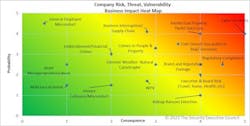One of the recommendations we frequently make to new and struggling security leaders is to always be prepared to answer the big four "executive questions". Budgets, projects, new positions, expansion of headcount, new technology, elevated role, or even travel evoke the inevitable: Why, what, how, and how much. This may seem simplistic, but it can get to the root of all types of program limitations, vulnerabilities, inefficiencies, lack of executive influence and even failures.
Of these questions seldom addressed in advance, the one most frequently assumed or skipped over by many security leaders is "Why?" Yet it's the most important question to win support. Friedrich Wilhelm Nietzsche was a German philosopher born in 1844 and influenced the discipline. One of his most famous quotes is: "People will do almost any "what," if you give them a good "why."
Agreement on "why" is the first step in translating your strategy into a compelling leadership message. Most executives have little firsthand security experience. Despite executives owning the risks you are trying to mitigate and having the authority to accept or mitigate the risk, they seldom have any depth in understanding the risk severity or consequences. The most critical first step is to get their agreement on "why" we need to take mitigation measures.
The Sticking Point: Why?
"Why are we doing this?" This question, unfortunately, is sometimes asked by senior management before security leaders have answered it for themselves.
Why does the business need these security programs? Why should I care? Why should we spend this much money on this? Why do employees have to do awareness training? Why require security duties of site managers? Why do we need a GSOC? Why does security have to travel with the executives? Why are business unit leaders being asked to commit their time to security tabletop exercises? Why should we approve this capital project? Why should I take this to my boss for approval?
The answer to "Why?" should always point to a specific, organization-level risk. No action or decision should be undertaken by security unless it can be connected directly to a specific risk to the organization. Absent this connection, any security expenditure, proposal, program, or service will represent a waste of organizational resources.
Using a risk heat map is a great way to visually articulate the why.
Everything security leaders do should revolve around risk mitigation – so why is this so often the hardest question of all?
Sometimes, it's because security programs are launched based on a demand from senior management, motivated by, for instance, an uptick of a certain type of event in the news cycle. These "issue of the moment" programs may not be attached to specific risks to the company at all.
Sometimes it's because the security function is tied to doing things the way they have been done in the past. Particularly if the security leader has been hired into a legacy department, or if the governance structure is such that the leader has little control over higher-level decisions, asking why certain programs exist may not feel intuitive. This leader may not feel they have the authority to ask such questions, and they are quite likely not to feel they have the time.
What and How: The Low-hanging Fruit
These tend to be the easiest and first questions for security leaders to address when making a proposal or introducing a program. Too often security leaders, to their detriment, focus exclusively on these two. They never or too late address the why in terms the executives understand.
What is our security vision, mission and strategy? What are the relevant programs and services that make up the security function? What technology will be deployed? What resources will be impacted? What regions will this entail? What disruptions will this cause?
How will you do this? Vendors, contractors, or matrixed organization? How will security deliver its services and programs – through a centralized, distributed, or governance and oversight model? How will this impact the risk or issue? How long will it take to see the results? How many other functions will be impacted? How much inconvenience will this cause? How will the complicate the existing process?
These are important and expected answers you must present or be ready to address. Way too often in our careers, we seek innovations and new services that can be deployed. We are often drawn to new shiny objects. Unfortunately, we often overlook their relationship with why.
[For more on service delivery models, read When Your Security Proposals Keep Hitting a Wall, Try Looking at Your Security Service Delivery Model].
How Much: Easier with Metrics
Many security leaders can quickly and accurately answer the easiest "how much" questions. How much will this cost? How much of the staff/employee's time will it require? How much will this add to their existing workload? How much time does it take to set up? How much bandwidth will these new technologies require? How much money do we need to invest in this? How many business units need to be involved? How much business interruption will result from the implementation or maintenance of these services and technologies?
All of these are must-haves when making the proposal. But do not forget that eventually, you will have to answer other more difficult how much questions. How much impact will this have? How will you measure the risk reduction? How much value did this investment add versus the cost? How much safer are we? How much less likely are we to have this problem because of this investment?
Having a solid metrics program helps exponentially with questions like these and then goes beyond counting to providing meaningful insight into the function and its performance.
[For more on security metrics, visit https://securityexecutivecouncil.com/insights/security-metrics.]
[For more on understanding security's stakeholders, read Three Ways to Improve Buy-In from Your Internal Customers]
Note: This article has been posted with permission from the SEC.
The Security Executive Council can help build the success story for your security function. Let us help you develop the most valuable answers to why. Contact them to find out how.
Bob Hayes is the principal architect and founder of the Security Executive Council (SEC). He led the groundbreaking industry research project that resulted in the first and only research-based organization specializing in identifying and quantifying the underlying factors of successful security programs and security leaders. He has applied his 25 years of security executive and law enforcement experience to defining the work of security practitioner program success. Utilizing the findings of the SEC’s sister organization, The Security Leadership Research Institute, the SEC has published over 50 books, and hundreds of articles, and more than 30,000 practitioners from around the world subscribe to the free monthly newsletter sharing their findings. 12,000 plus practitioners visit the SEC website every month and download hundreds of success multipliers.
Bob is a recognized innovator in the security field. He has received numerous awards and recognitions and belongs to leading security organizations. He is a frequent speaker at universities, and key industry events and is a leading expert on security management trends and issues. His work or quotes have appeared in dozens of magazines and publications. He has been quoted by major media outlets including The Wall Street Journal and Forbes.
Kathleen Kotwica, PhD, is EVP and Chief Knowledge Strategist for the Security Executive Council (SEC) and the Principal Analyst at the Security Leadership Research Institute (SLRI).
Kathleen's responsibilities include establishing short- and long-term knowledge strategies to maximize the SEC's innovative output and uphold its mission to the SEC's security leader community. She leads the development and production of SEC tools, solutions, websites and publications. She also oversees online marketing initiatives and communications. In her role, Kathleen maintains the strategic goals and direction of the SEC. She additionally researches security leadership and program success.
Kathleen has worked both in academia and business. The combination of experiences has resulted in an approach toward processes and research that maintains a focus on intended business goals. She enjoys identifying patterns in information and stored knowledge that can help businesses maintain a competitive advantage in the marketplace.






